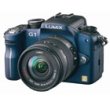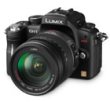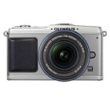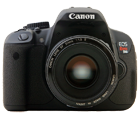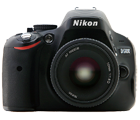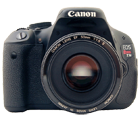Micro 4/3rds Digital Cameras |
Page updated: June 2009
|
The concept behind a Micro 4/3rds digital camera doesn't seem all that innovative at first — until you understand more about this brand new class of digital camera.
Let's get two things straight right now:
- A Micro 4/3rds camera is not a compact
- A Micro 4/3rds camera is not an SLR
Instead, it settles squarely in the middle of the two. A Micro 4/3rds digital camera is a hybrid: a cross between an advanced compact camera and a digital SLR.
It borrows some of the best features that both types of cameras have to offer and wraps it up in a package that has the potential to be extremely appealing to a huge number of consumers.
Who are these people?
They're the ones who have been using compact digital cameras for years, and are looking for faster performance and better image quality.
At the same time, they love the portability of their compact camera, and can't imagine toting around a heavy bulky camera all the time.
Small size, low weight, interchangeable lenses and superior image quality - this is what micro 4/3rds cameras are all about.
Bye, Bye Pentaprism
The "R" in SLR stands for "Reflex" and this refers to the way that an SLR displays an image in its viewfinder.
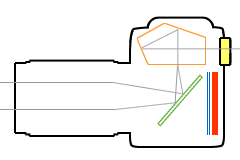
As light passes through the lens, it strikes a mirror, which reflects the image up to a set of mirrors that bends the light 90 degrees so that you can see an image in the viewfinder.
With digital SLR cameras the device that bends the light is either called a pentaprism (one solid block of reflective material cut to bend light) or a pentamirror (a group of mirrors that do the same thing as a pentaprism).
Pentamirrors aren't quite as bright as pentaprisms, but they are lighter, and are used in many of the small sized digital SLRs (like the Canon XS or the Nikon D60).
Whether one or the other is used in a digital SLR, the end result is the same: this set of mirrors (the "reflex" system) allows you to see exactly what the lens sees.
Since it is an analog system (instead of digital), you can move the camera rapidly to track a moving subject, and the image in the viewfinder will stay perfectly clear (as if you were looking at your subject through binoculars).
The reason a Micro 4/3rds digital camera is not an SLR is because it does away with all of these mirrors and replaces them with an Electronic Viewfinder (or EVF).
The Electronic Viewfinder is like a tiny monitor that lives behind the eyepiece of the digital camera. When you put your eye up to it to take a photo, the image that you see is a live feed from the camera's digital sensor.
It's the exact same image that you'd see if you were using the camera's LCD screen to compose an image instead of the viewfinder.
If it's identical, why have a viewfinder at all?
There are instances - often in bright sunlight - where trying to see the image on the camera's LCD can be quite difficult. For these times, it's much more convenient to compose your photo by looking through the viewfinder.
The upshot of removing the mirror system that is available in every "true" digital SLR camera is that the size and weight of the camera can be dramatically reduced.
Meet the New EVF
I stated in the previous section that Micro 4/3rds cameras replace the pentaprism/pentamirror with an Electronic Viewfinder (EVF).
If these were still the formative days of digital camera technology, this would be a HUGE step back in terms of performance.
Older EVFs have a limitation called image latency. This means that if you're looking at an EVF and move the camera quickly, subjects in the EVF become blurry or "ghosted".
This is because the electronics used to drive the viewfinder display can't keep up with a fast-moving camera.
Optical viewfinders (the ones made up of mirrors) have no such limitation: you can watch a race car tear past in an optical viewfinder that is just as clear as watching it with your own eyes.
The good news is that the development of EVF technology has come a long way - modern EVFs have reduced image latency so much that they perform much more like optical viewfinders.
No, they're not identical, but this might a small amount of viewfinder latency might be less of a bother to you than having a huge, heavy camera hanging around your neck.
Small Size, Low Weight
The big benefit of eliminating the pentaprism/pentamirrors is that a Micro 4/3rds camera is closer in size to a compact camera than to an SLR.
However, you can still change the lens.
Furthermore, the image sensor inside the camera is the same size as a SLR sensor rather than the tiny size of most compact digital sensors.
I won't go into a detailed explanation of why larger sensors capture better images - that's pretty well detailed in my page on full-frame digital SLR cameras.
Let's just say that the payoff here is an important one: clearly superior image quality, especially in low light situations.
So, you get some of the main benefits of owning a digital SLR, but in a smaller, lighter package:
- You can change the lens as often as you like to suit a specific photographic need
- You get higher image quality, and less noise at high ISO settings
There's only one other significant area where a Micro 4/3rds camera can differ from a true SLR, and it's an important one: speed.
Time - and testing - will show whether Micro 4/3rds cameras have the same quick autofocus and shutter mechnisms that make digital SLRs so appealing.
If they do, this will open the door to a huge number of photographers who are deeply frustrated with the slow performance of their compact digital cameras but who aren't quite ready to make the leap to a full-blown SLR.
Micro 4/3rds vs. 4/3rds
The Micro 4/3rds format is actually a spin-off from an existing digital SLR format: something just called 4/3rds.
Originally introduced by Olympus in their line of E-series digital SLR cameras, the 4/3rds format created a standard lens mount system so that you could use a lens from ANY manufacturer on ANY 4/3rds camera.
Eventually, the 4/3rds format was also adopted by Panasonic, who partnered with Olympus on the development of a small number of digital SLRs.
The good news for anyone with either an Olympus digital SLR (E-300, E-330, E-500, E-410, E-420, E-510, E-520, E-3) or a Panasonic digital SLR (DMC-L1) is that 4/3rds lenses can be attached to a Micro 4/3rds camera with an adapter.
The essential difference between 4/3rds cameras and Micro 4/3rds cameras is that the former still have pentaprisms or pentamirrors while the latter do not.
Current Micro 4/3rds Digital Cameras
If you're in the market for a Micro 4/3rds camera, there aren't too many to choose from.
Since this is an emerging technology, there are a limited number of cameras (and lenses) that leverage the new format.
However, if this type of hybrid camera catches on with consumers, expect to see a lot more Micro 4/3rds cameras hitting the market.
| CAMERA | RELEASE | SPECIFICATIONS | AVG. COST |
|---|---|---|---|
|
Panasonic DMC-G1
|
December 2008 |
|
$623 USD
COMPARE AT:
|
|
Panasonic DMC-GH1
|
July 2009 |
|
$1,500 USD
COMPARE AT:
|
|
Olympus E-P1
|
July 2009 |
|
$800 USD
COMPARE AT:
|
| Digital SLR Home |
